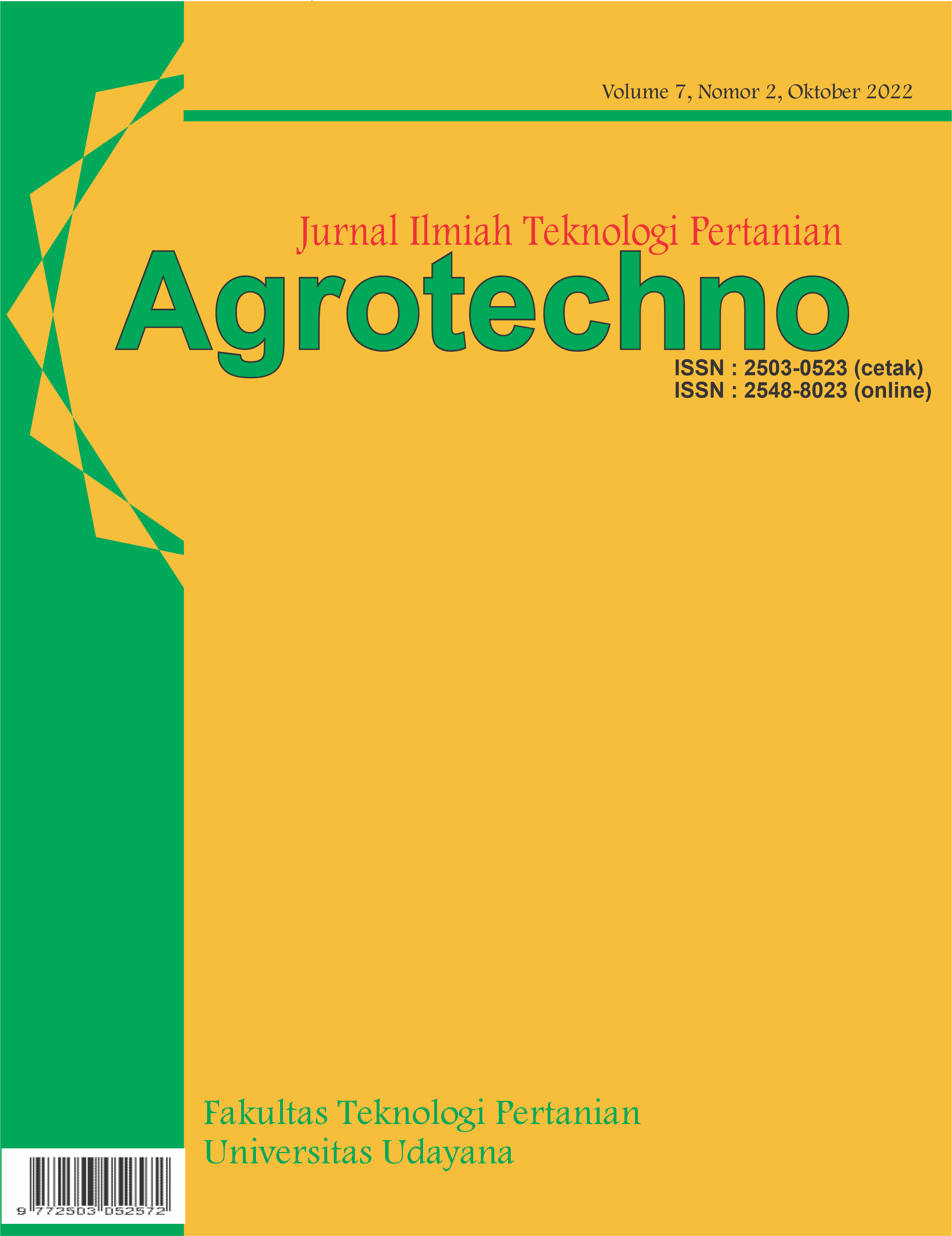Karakteristik Komposit Bioplastik Pati Umbi Talas (Colocasia esculenta) dan Karagenan pada Variasi Rasio Bahan Baku dan Konsentrasi Bahan Penguat
Abstract
Bioplastic is one type of plastic that can be degraded naturally because it uses organic materials. This purpose of this study is to determine the effect and interaction of variations in the ratio of raw materials and concentration of reinforcing materials on the characteristics of the bioplastic composites of taro tuber starch (Colocasia esculenta) and carrageenan as well as to determine variations in the ratio of raw materials and concentrations of reinforcing materials in the manufacture of bioplastic composites of taro tuber starch (Colocasia esculenta) and carrageenan which produces the best bioplastic composites. This study used a Factorial Randomized Block design with two factors, namely the ratio of taro tuber starch: carrageenan which consisted of three levels, namely (25:75; 50:50; 75:25 g) and the concentration of cellulose acetate as a reinforcing agent which consisted of 3 the level of (1.67; 5; 8.33%) of polymeric materials. The treatments were grouped into 3 based on the time of making bioplastics, so that 27 experimental units were obtained. The observed variables were tensile strength, elongation at break, modulus young, swelling, biodegradation and functional groups using FTIR. The obtained data were analyzed for diversity and continued with the Honest Significant Difference test. The results showed that the interaction of variations in the ratio of raw materials and concentration of reinforcing materials had a very significant effect on tensile strength, elongation at break, modulus young and biodegradation but had no significant effected the swelling. The characteristics of bioplastic composites in the variation of the ratio of raw materials and concentration of reinforcing materials produced the best values, the tensile strength of 17.60 MPa, elongation at break of 14.91%, modulus young of 154.80 MPa, swelling of 7.52%, biodegradation for 6 – 8 days and contains hydrocarbon functional groups (-(CH2)n), alkenes (C – H), alkanes (C – H), phenols, alcohol monomers, hydrogen bonded alcohols (O – H).
Downloads
References
Ginting, M. H. S., R. F. Sinaga, R. Hasibuan dan G. Ginting. 2014. Pengaruh variasi temperatur gelatinisasi pati terhadap sifat kekuatan tarik dan pemanjangan pada saat putus bioplastik pati umbi talas. Prosiding Seminar Nasional Sains dan Teknologi, Fakultas Teknik Universitas Muhammadiyah.
Hartiati, A., B. A. Harsojuwono, H. Suryanto dan I. W. Arnata. 2021. Synthesis of starch-carrageenan bio-thermoplastic composites on the type and concentration of thermoplastic forming materials as packaging materials. IOP Conf. Series: Earth and Environmental Science 913. DOI : 10.1088/1755-1315/913/1/012030
Indriyanti, R. 2019. Pembuatan bioplastik menggunakan selulosa asetat limbah tandan kosong kelapa sawit dan pati umbi ganyong (Canna edulis kerr) dengan penambahan variasi gliserol sebagai plasticizer dengan melakukan uji mekanik. Skripsi. Tidak Dipublikasikan. Universitas Brawijaya, Malang.
Lailyningtyas, D. I., M. Lutfi dan A. M. Ahmad. 2020. Uji mekanik bioplastik berbahan pati umbi ganyong (Canna edulis) dengan variasi selulosa asetat dan sorbitol. Jurnal Keteknikan Pertanian Tropis dan Biosistem. 8(1): 91-100. DOI : http://dx.doi.org/10.21776/ub.jkptb.2020.008.01.09
Limbong, S. F. B. A. Harsojuwono dan A. Hartiati. 2022. Pengaruh konsentrasi polivinil alkohol dan lama pengadukan pada proses pemanasan terhadap karakteristik komposit biotermoplastik maizena dan glukomanan. Jurnal Ilmiah Teknologi Pertanian. 7 (1): 37-46. DOI : https://doi.org/10.24843/JITPA.2022.v07.i01.p05
Maladi, I. 2019. Pembuatan bioplastik berbahan dasar pati kulit singkong (Manihot utilissima) dengan penguat selulosa jerami padi, polivinil alkohol dan bio-compatible zink oksida. Skripsi. Tidak Dipublikasikan. Universitas Islam Negeri Syarif Hidayatullah, Jakarta.
Munir, M. I. D.G. 2017. Penentuan konsentrasi optimum selulosa ampas tebu (baggase) dalam pembuatan film bioplastik. Skripsi. Tidak Dipublikasikan. Universitas Islam Negeri Alauddin, Makassar.
Naki, M. S. dan I. A. M. S. Wake. 2021. Pemanfaatan pati umbi talas (Colocasia esculenta l.) sebagai bahan pembuatan bioplastik. Action Research Literature. 5 (1): 7-13. DOI : https://doi.org/10.46799/arl.v5i1.6
Nayiroh, N. 2013. Teknologi material polimer. http://nurun.lecturer.uin-malang.ac.id/wp-content/uploads/sites/7/2013/03/Material-Komposit.pdf. [Diakses tanggal 4 April 2022].
Novilestari, A. 2016. Pengaruh komposisi kitosan dan sorbitol pada pembuatan plastic biodegradable dari pati talas dan bahan tambah pati kulit jagung. Skripsi. Tidak Dipublikasikan. Politeknik Negeri Sriwijaya, Palembang.
Nuriyah, L., S. J. Iswarin dan Wiyono. 2011. Karakteristik sifat mekanik bioplastik dari pati ubi kayu dengan pemlastis gliserol dan sorbitol. Jurnal Natural B. 1 (1): 21-26.
Panjaitan, R. M., Irdoni dan Bahruddin. 2017. Pengaruh kadar dan ukuran selulosa berbasis batang pisang terhadap sifat dan morfologi bioplastik berbahan pati umbi talas. Jurnal Online Mahasiswa Fakultas Teknik Universitas Riau. 4(1): 1-7
Permana, K. D A., A. Hartiati dan B. Admadi H. 2017. Pengaruh konsentrasi larutan natrium klorida (NaCl) sebagai bahan perendam terhadap krakteristik mutu pati ubi talas (Calocasia esculenta L. Schott). Jurnal Rekayasa dan Manajemen Agroindustri. 5 (1): 60-70
Pratama, B. D. 2019. Uji biodegradabilitas bioplastik berbahan pati umbi ganyong dengan variasi gliserol dan selulosa asetat. Skripsi. Tidak Dipublikasikan. Universitas Brawijaya, Malang.
Pujawati, D., A. Hartiati dan N. P. Suwariani. 2021. Karakteristik komposit bioplastik pati ubi talas-karagenan pada variasi suhu dan waktu gelatinisasi. Jurnal Rekayasa dan Manajemen Agroindustri. 9 (3): 277-287. DOI : https://doi.org/10.24843/JRMA.2021.v09.i03.p02
Rahim, A., N. Alam, H. Haryadi dan U. Santoso. 2011. Karakteristik edibel film dari pati aren amilosa tinggi dan aplikasinya sebagai pengemas bubuk bumbu mie. Jurnal Agroland. 18 (1): 15-21.
Rambe, M. A. AJ. 2017. Pembuatan dan karakterisasi plastik edible film dengan pemanfaatan pati kulit ubi kayu (Manihot utilissima pohl.) dan keratin bulu ayam. Skripsi. Tidak Dipublikasikan. Universitas Sumatera Utara, Medan.
Sari, N. N. 2021. Aplikasi serat nanoselulosa dari kulit ubi kayu sebagai bahan pengisi dan pengaruhnya terhadap sifat fisik bioplastik tapioka dengan penambahan sorbitol. Skripsi. Tidak Dipublikasikan. Universitas Islam Negeri Syarif Hidayatullah, Jakarta.
Setiarto, R. H. B. 2020. Teknologi pengemasan pangan antimikroba yang ramah lingkungan. Bogor: Guepedia.
Simarmata, E. O., A. Hartiati dan B. A. Hasojuwono. 2020. Karakteristik komposit bioplastik dalam variasi rasio pati umbi talas (xanthosoma sagittifolium)-kitosan. 5(2): 75-80.
Sinaga, R. F., G. M. Ginting, M. H. S. Ginting dan R. Hasibuan. 2014. Pengaruh penambahan gliserol terhadap sifat kekuatan tarik dan pemanjangan saat putus bioplastik dari pati umbi talas. Jurnal Teknik Kimia USU. 3 (2): 19-24. DOI : https://doi.org/10.32734/jtk.v3i2.1608
Sudomo, A. dan A. Hani. 2014. Produktivitas talas (Colocasia Esculenta L. Shott) di bawah tiga jenis tegakan dengan sistem agroforestri di lahan hutan rakyat. Jurnal Ilmu Kehutanan. 8 (2): 100-107. DOI: https://doi.org/10.22146/jik.10166
Sugiarto. 2014. Pengembangan film komposit tepung ubi kayu termoplastik-linear low-density polyethylene (LLDPE). Disertasi. Tidak Dipublikasikan. Institut Pertanian Bogor, Bogor.
Sulityo, H. W., dan Ismiyati. 2012. Pengaruh formulasipati singkong-selulosa terhadap sifat mekanik dan hidrofobisitas pada pembuatan bioplastik. Jurnal Konversi. 1 (2): 23-30. DOI: https://doi.org/10.24853/konversi.1.2.%25p
Suparwan, K. G. I., A. Hartiati dan L. Suhendra. 2021. Pengaruh jenis dan konsentrasi bahan pengisi terhadap karakteristik komposit bioplastik pati umbi gadung-karagenan. Jurnal Rekayasa dan Manajemen Agroindustri. 9 (3): 312-322. DOI : https://doi.org/10.24843/JRMA.2021.v09.i03.p05
Wahyudi, B., M. B. H. Kasafir dan M. R. T. Hidayat. 2020. Sintetis dan karakterisasi bioplastik dari pati talas dengan selulosa tandan kosong kelapa sawit. Seminar Nasional Soebardjo Brotohardjono, 16. http://snsb.upnjatim.ac.id/index.php/snsb/article/view/30. (Diakses pada 26 Juli 2022).
Wahyuningtyas, N. E., dan H. Suryanto. 2017. Analysis of biodegradation of bioplastics made of cassava starch. Journal of Mechanical Engineering Science and Technology. 1 (1): 41-54.
Waryat, M. Romli, A. Suryani, I. Yuliasih dan S. Johan. 2013. Penggunaan compatibilizer untuk meningkatkan karakteristik morfologi, fisik dan mekanik plastik biodegradable berbahan baku pati termoplastik polietilen. Jurnal Sains Materi Indonesia. 4 (3): 214-221.
Wiradipta, I. D. G. A. 2017. Pembuatan plastik biodegradable berbahan dasar selulosa dari tongkol jagung. Skripsi. Tidak Dipublikasikan. Institut Teknologi Sepuluh Nopember, Surabaya.










